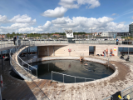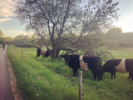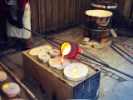Chronicles from Aarhus, Denmark

a photo essay by Jenna Herbert (BS Arch '19)
Published June 18, 2019 This content is archived.
UB architecture student Jenna Herbert shares her exploration of digital fabrication and materiality as an exchange student at the Aarhus School of Architecture (Arkitektskolen Aarhus).
Jenna Herbert says she was drawn to the Aarhus exchange program because it offered her the opportunity to explore a new city on her own. "I knew that an exchange program would force me out of my comfort zone. I set out on this program not only to learn about architecture, but to learn about myself and a whole new culture."

Since arriving in Denmark, I feel as though I have experienced so much of the average daily life of a new place and have grown so much from this cultural exposure. I have made friends from not only Denmark, but also around all of Scandinavia. I have met students from other exchange programs and made close friends from Australia to Colombia while on this journey. I have learned things from living in Denmark that I hope to carry with me for the rest of my life.
Studio 2B: Digital fabrication and material exploration

Arkitektskolen Aarhus is located in Aarhus Central, spread out in nearby buildings that tie directly into the rest of the city. The campus features many different types of buildings and inviting courtyards.
The school is well equipped in terms of facilities, with an extensive library, a woodworking shop, dozens of 3D printers of different capabilities, and a robotics lab.

The program I participated in, Studio 2B, is a masters studio that falls under habitation but is known for its large amount of digital output and material investigations. Our primary project was to design a whiskey distillery as an infill project on an existing site in the south harbor of Aarhus. As a whole, we prefaced the building project by completing a series of analogue and digital exercises. We began the semester with photogrammetry scanning and 3D printing objects.

As one of our material investigations, we participated in a bronze casting workshop using plaster molds created via the lost-wax process. By placing a 3D printed object into plaster and firing it in the kiln to burn out the plastic print, we were left with a void in the plaster taking on the form of the printed object that would then be filled with bronze.

We then completed a CNC workshop which allowed us to investigate the properties of the wood we were working with as well as the digital technology behind CNC milling. The result of the workshop was a frame to tie together two objects from the bronze workshop.

The building site for the semester was in Sydhavnen, the south harbor of Aarhus. Like much of Denmark, the site exhibited buildings constructed entirely of brick. The brick construction of Denmark is something that drew me to the country in the first place. As a student from the United States, where brick is less common, I was interested in using it as a material for my semester project.

Rather than just using brick as a final material, I decided to make use of the facilities the school offers and, influenced by the work of faculty and students at ETH Zurich, try to use robotic brick stacking to inform my design. By using digital technology to construct with one of the oldest building materials known to man, I was able to test the limits of the material and better understand it, all while designing a project that would tie into the existing buildings and exhibit a new quality not seen in the area.
Aarhus: exploring the city

With Aarhus located on the Kattegat Sea, we are given unique experiences that otherwise couldn’t exist. The Aarhus Harbour Baths, Designed by BIG, became one of my favorite places to go. The complex features the world's largest seawater baths as well as saunas and sunbathing decks. The baths are used year round, even in the winter months. Being able to go from the hot sauna and into the freezing cold water is back to the sauna is an experience unique to Scandinavian countries.

The Danish culture has a large emphasis on farm life and cattle. While living in the city center we are separate from the farm life, there is a large park with roaming cattle. Seeing the cows during my evening runs became something I really looked forward to.

ARoS art museum features a rooftop deck that allows some of the greatest views of the city. The art museum also has a permanent installation designed by Icelandic artist Olafur Eliasson called the rainbow panorama, which allows visitors to walk through a circular rainbow glass bridge and experience the same great views of the city through colored glass.









